
by Simon Williamson | Jan 12, 2023 | News
There are many wonderful benefits of owning your own low maintenance hedges. You give your garden a beautiful boost and do so at a minimal cost to yourself! No need to worry about tending to your hedges religiously, instead you can just enjoy your new view. And that’s not to mention you can improve your property value. So let’s dig in our troughs and start cutting through the 7 benefits low maintenance hedges can give you!
Easy care and maintenance

One of the more low maintenance hedges – Common Box (Buxus sempervirens)
Hedges such as the Common Box (Buxus Sempervirens) are easy to care for and are one of the best small hedge plants. This particular variety is the classic low evergreen hedge for border edging. They can add a touch of class to any garden, and if you so desire, can be trimmed tightly to maintain a formal shape. One of the advantages of choosing hedges that require little attention is the fact they will grow nearly anywhere. So regardless of whether you have a large or small space, you can rest assured you will keep these alive.
Save on labour and equipment
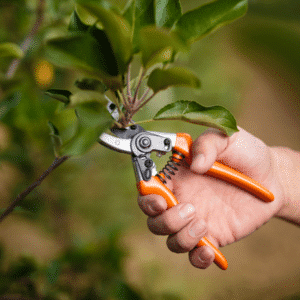
Low maintenance hedges are the more cost-effective choice for obvious reasons. Less care is needed, so less labour is needed! Regardless of your intended landscaping or gardening project, choosing hedges with this in mind will speed up completion. If speed is something you have in mind, fast growing hedge plants such as the Lonicera nitida might be right up your street!
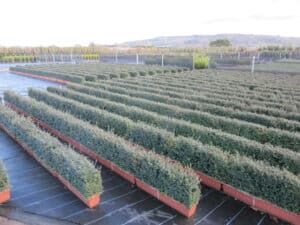
Lonicera nitida is a fast-growing hedge plant
However, faster growing does indeed mean more pruning! So, sometimes a balance between speed and maintenance is something to think about. It’s an important consideration for homeowners and businesses. Traditional hedges can indeed be time-consuming, often needing a gardener to be hired to do the work! With low maintenance hedges, you can save money on additional labour, and also equipment costs. The less you need to prune your hedges, the longer your equipment will last. So, the slower your hedge grows the more time and money you will save.
Increase your property value

A well-maintained hedge can improve the overall appearance of your garden, holistically improving your property. For potential buyers, it will be attractive to see that their garden will have added privacy, and can also help them envision themselves having an enjoyable time in your space. In summer months, larger hedges can also provide shade for your home, which can lower the cost of cooling the house.
More time to enjoy your garden
The less time you spend nurturing your hedges, the more time you have to enjoy the results. This is a great one that you shouldn’t overlook! Why even have a garden if you never have time to enjoy it? Don’t forget why you might have started improving your home in the first place.

Variety of options for different climates and spaces
You might think by narrowing your search to low maintenance hedges, you’d cut through many of your options. Luckily, there are many varieties of low maintenance hedges to choose from! If you are stuck for space, perhaps low growing hedges will be more your style.

A low-growing hedge, the Euonymus Jean Hugues
Perhaps you’re after something hardier that can take all kinds of weather conditions? A yew hedge can be grown in a variety of soils. This deciduous hedge also requires very little pruning, and due to its thickness, it can also act as a windbreak. One thing to note though, you’ll need to provide drainage – yew is not a fan of too much moisture!
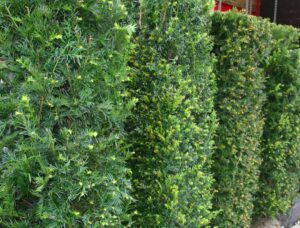
Yew Hedge – fool-hardy and evergreen
Or, maybe you’re looking for tall hedges for privacy. This brings us to our next point!
Low maintenance hedges can still provide privacy and aesthetic appeal
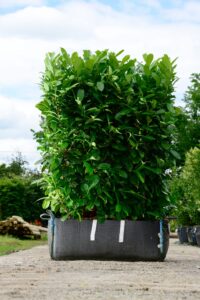
Prunus lau. Rotundifolia, or Common laurel.
Thick hedges such as the Prunus lau. Rotundifolia, also known as Common laurel or Cherry Laurel can provide excellent privacy for your garden. It can also be used to cover some more unsightly areas, for instance, a shed or old fencing. Best suited as a boundary hedge, Common laurel is a good example of a hedge that provides both privacy and aesthetic appeal.
Reduced risk of damage caused by over-pruning or neglect.
Not only that, but low maintenance hedges are far less likely to suffer damage from over-pruning, and also are less likely to die if neglected. So you can worry less about replacements or repairs to your hedges through professional help. Again, this makes this variety of hedges more cost-effective, which is always a good thing!
Top varieties for a stress-free Garden
With all of the benefits laid out for you, hopefully, you’ve started to think about what would suit you best! Low maintenance hedges can be neatly split into two categories:
Evergreen Hedges
What are evergreen hedges? Evergreen hedges maintain their foliage all year round, they won’t lose leaves in autumn or winter. This makes evergreen hedges very appealing! You won’t have to worry about privacy when it comes to the colder months, your hedges will keep up appearances every day of the year. There are a variety of evergreen hedge plants that you will be familiar with from this blog, including the Common Box. They lend themselves to being low maintenance by saving you time, you won’t have to be picking up any dead leaves, and typically require less pruning than deciduous hedges.
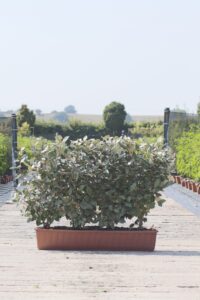
The evergreen Elaeagnus eb. Compacta
Deciduous Hedges
What are deciduous hedges? Deciduous hedges are plants that lose their leaves in autumn and winter. Typically, deciduous hedges have green leaves through spring and summer and lose them through the colder months. You might be thinking this makes evergreen hedges the clear winner, but according to the Royal Horticultural Society, an advantage of a deciduous hedge is that it will filter wind in winter avoiding the damaging turbulence associated with dense evergreen hedges. So, if your garden is susceptible to high winds in the winter, it might be beneficial to go for a deciduous hedge to help ease the potential damage.
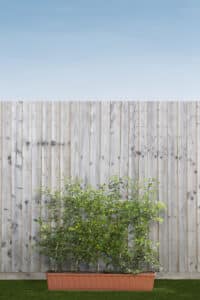
The deciduous hawthorn, or crataegus monogyna
Closing thoughts
Hopefully, by now you can see the many wonderful benefits of owning your own low maintenance hedges. Maybe the real question is ‘what is the easiest hedge to maintain?‘, and that can depend on your outlook. If you’re after something that you don’t have to think about too much, you can’t go wrong with the common laurel. If you’re after something a bit more upmarket, perhaps you might like the broadleaf. Whatever you might be into, we have a diverse range here at Readyhedge and we are always here to help you make an informed decision. Please don’t hesitate to contact us with any queries!

by Simon Williamson | Dec 21, 2022 | News
Are you looking for the perfect evergreen hedge shrub to add that extra ‘oomph’ to your garden? If so, then this post is just what you need! Here we will discuss the best options for evergreen hedges suitable for every garden size and style – from a formal low-growing ornamental privet to colourful flowering varieties. There are many shades of green among these varied choices.
We have done our research and handpicked some of the most beautiful and hardy trees that bring lots of beauty into your outdoor space and provide excellent privacy screening all year round – whatever type of gardener you may be! So, if it’s time to upgrade your landscape, read on and learn more about choosing the ultimate evergreen hedge shrub for your beloved abode.
Why Are Evergreen Hedge Shrubs Important?
Evergreen hedge shrubs are essential because they provide year-round coverage and privacy, reduce the amount of noise from the outside environment, create a wind break for your property, attract wildlife such as birds, form a visual barrier from neighbouring properties or roads, and increase the aesthetic value of your home. Evergreen hedge shrubs also require little maintenance compared to other plants and can last for years with minimal care.
Best Evergreen Hedge Shrubs For Your Garden
The best evergreen hedge shrubs for your garden are Common Box, Griselinia Littoralis, Lonicera Nitida, Holly, Arborvitae, etc. These plants provide stunning foliage that maintains its colour all year round. They create an excellent windbreak that can help reduce outside noise and provide privacy. Here’re the 10 Best Evergreen Hedge Shrubs For Your Garden.
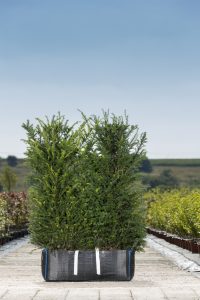
Taxus Baccata, commonly known as English Yew, is a coniferous tree species native to most parts of Europe. It has long been a popular ornamental hedging plant due to its dense evergreen foliage and attractive red berries. Its hardwood is also highly prized for use in making furniture and musical instruments. English Yew is widely used in formal gardens and cemetery settings due to its symmetrical shape and slow growth habit.
English Yew is easy to grow and prefers well-drained soils in sun or partial shade. It can reach heights of up to 20 meters and will live for several hundred years. Its evergreen foliage provides privacy, shelter, and beauty throughout the year. The red berries are poisonous but provide a valuable food source for birds in winter.
Common box is a versatile plant with many uses in the garden! It is ideal for edging paths and beds or creating low hedges. Its dense foliage also makes it an excellent choice for topiary work. It is often used for hedging and topiary due to its dense habit and small, glossy leaves. It is tolerant of light shade but prefers a sunny position with moist soil. Pruning will help keep it neat and encourage more flowers to be produced in summer.
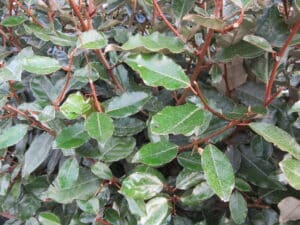
Elaeagnus Eb. Compacta is a small shrub with attractive foliage and fragrant flowers. This evergreen plant has silvery-grey leaves and produces white flowers that blossom from late summer to early winter. It grows best in full sun or partial shade, and its compact size makes it ideal for container gardens or landscaping beds. Elaeagnus Eb. Compacta’s hardiness and low maintenance make it an excellent choice for gardeners of all experience levels.
Griselinia littoralis, also known as New Zealand broadleaf, is an evergreen shrub native to New Zealand. It has a dense crown of glossy green leaves that can reach over 10 meters in height and produces small yellow-green flowers in spring. Its tolerance for salt spray makes it perfect for coastal gardens and parks, providing year-round interest with its bright foliage and attractive form. The species is also widespread for windbreaks, hedging, and shelter.
The Ilex Crenata is an evergreen shrub native to Japan, Korea and China. It has dark green holly-like foliage with small yellow flowers that later form blackberries. It has a slow growth rate, making it ideal for hedges, topiaries or foundation plants. The Ilex Crenata can be pruned and shaped into desired shapes and used as an ornamental plant in gardens or yards. This plant is a great choice for privacy screens or windbreaks and can even be used in bonsai. It is also ideal for those who want a low-maintenance plant, as it requires minimal pruning.
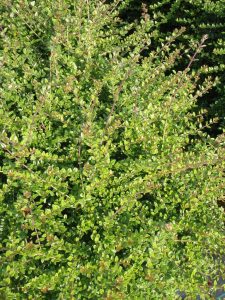
Lonicera nitida Foliage
Lonicera Nitida, commonly known as the Box-Leaved Honeysuckle, is a flowering shrub native to parts of Europe and Asia. Its evergreen foliage is dense and compact, making it an ideal choice for hedges and topiary gardens. It also produces fragrant white flowers in the summer, which are attractive to pollinators. This hardy shrub is easy to maintain and adds to any outdoor space.
Osmanthus Burkwoodii is an evergreen shrub native to China, growing up to 8 feet tall with fragrant white flowers. It’s perfect for hedges and borders, offering privacy in the summer months due to its dense foliage and an intoxicating scent when it blooms in late autumn. The Osmanthus Burkwoodii is a versatile plant that can thrive in full sun or partial shade. It’s easy to care for, requiring little more than an occasional pruning and a regular watering schedule. It can be used in formal gardens or as a single specimen plant, and it’s an excellent choice for those looking to add a touch of luxury to their outdoor space.
Photinia Carre Rouge is an evergreen shrub with brilliant red foliage and white flowers in the spring. This hardy plant grows well in full sun or partial shade, making it an excellent choice for hedges, borders and foundation planting. Its glossy leaves provide year-round colour and texture to the landscape, while its fragrant blooms attract birds and butterflies. Photinia Carre Rouge is an excellent choice for all gardens!
Phillyrea Angustifolia is an evergreen shrub or small tree native to the Mediterranean. It produces fragrant white flowers in mid-spring, followed by blue-black berries in late summer. Its glossy, dark green leaves are narrow and pointed, making it a popular choice for ornamental hedges and topiaries. With its hardiness and low maintenance needs, Phillyrea Angustifolia is also a great addition to any garden!
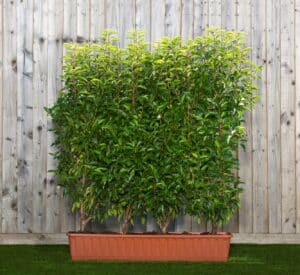
Prunus Angustifolia, commonly known as Chickasaw plum, is a small deciduous tree native to the southeastern United States. It is an essential food source for birds and other wildlife due to its abundant production of fruits that can be eaten fresh or used in jams and jellies. In addition, this species has excellent ornamental value with its showy white flowers and attractive red foliage in autumn. Prunus Angustifolia is an ideal choice for landscaping due to its low maintenance needs and tolerance to drought.
How To Plant And Care For Evergreen Hedge Shrubs
To plant and care for evergreen hedge shrubs, start by selecting a suitable variety of shrubs and preparing the planting site. Make sure to space them out according to their mature size and dig a hole twice as wide and deep as their root ball. Gently remove the shrubs from their containers, loosen any tightly wound roots, and add some compost or fertilizer before you place them in the hole. After you’ve filled in all the soil around each one, could you give them a thorough watering? For ongoing care, maintain regular maintenance such as pruning, weeding, mulching, fertilizing and watering throughout the growing season so that your evergreen hedge stays healthy and vibrant year-round!
To Wrap Up
As you can see, there are a variety of evergreen hedge shrubs to choose from that will suit any garden type. By considering the size and shape of your space and the level of light and moisture it receives, you can select the perfect plants for your needs. And with a bit of care, you’ll have a lush, green hedge that provides privacy and enhances the beauty of your home all year round!
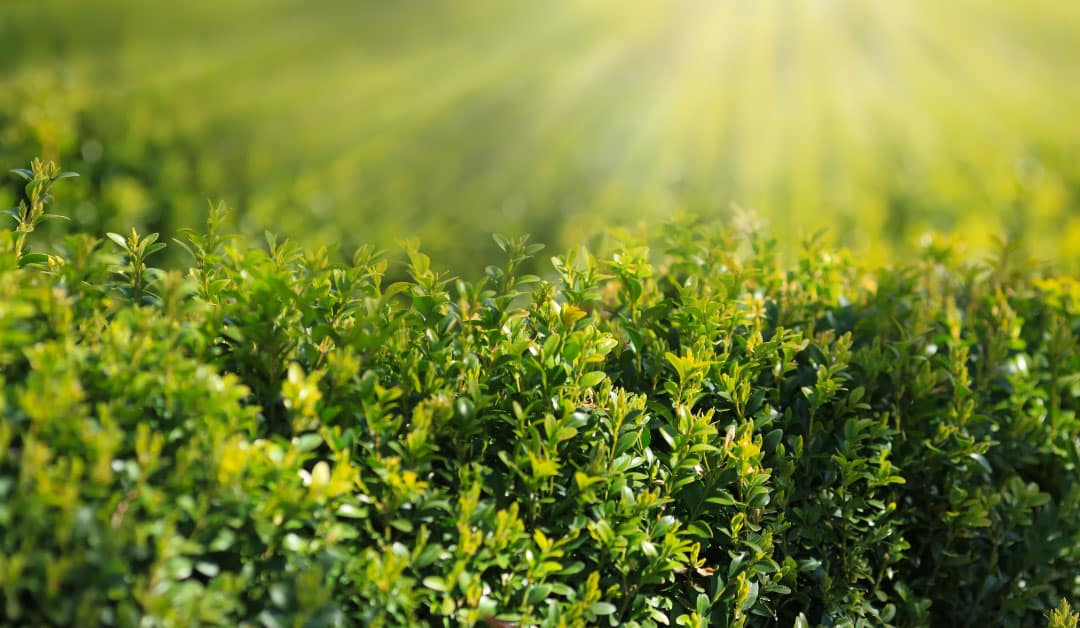
by Simon Williamson | Dec 8, 2022 | News
Earlier this year the RHS (Royal Horticultural Society) declared that homeowners should look to swap their fences for a hedge. This is after they began a climate study into the benefits of hedges for the environment.
How Hedges Tackle Climate Change
The RHS have begun conducting a study into which species of hedges are best for tackling the climate crisis and pollution.
It’s of particular focus in urban areas how green infrastructure can positively impact things like air pollution. The study, led by the RHS’s principal horticultural scientist, Dr Tijana Blanusa, investigates the properties of a variety of hedge species. This is to determine how they provide important ecosystem services as well as assessing the benefits of mixed hedging.
The key benefits to the environment include:
- Reducing pollution
- Improving air quality
- Slow the flow of rainwater
- Helps with flood management
- Provides shelter and habitats for wildlife
- Helps with the regulating of temperatures through shading and cooling
Hedges are the “Hero Feature in any Garden”
It’s often been said that hedges not only provide fantastic environmental benefits, but they also have many benefits for the homeowner.
Overall, they are relatively cheap, long lasting and act as an aesthetically pleasing, natural screen for your garden or outdoor space.
“Knowing which planting combinations to choose to get the most environmental benefit, and how to look after them effectively, could enable wider uptake as we seek to future-proof our towns and cities.” Blanusa said.
This study will look in greater detail at the different species and how they provide their benefits. The aim is to encourage more uptake of hedges.
Disadvantages of a Monoculture of Hedges
The RHS hope that with this study, more knowledge will be available to inform people of the benefits of different species and how to properly maintain them. As well as, how different breeds of hedges can effectively complement each other.
This will hopefully avoid situations of monoculture, which can unfortunately leave hedges susceptible to disease and limit biodiversity.
You can learn more about the study here on the RHS Website.
If you would like help and advice on your hedging requirements, including the ideal hedge for your soil type and climate, contact our helpful and friendly team today.

by Simon Williamson | Sep 8, 2022 | News
Autumn tends to bring about a lot of sprucing and cleaning chores, but many of these jobs will require that you stay outdoors, and many of them are all about or (in some way) related to gardening. Pruning the garden plants is an important chore for gardening that you should not be neglecting this autumn, especially since you need to prepare those plants for the negative consequences of the winter season! Trimming is, of course, one of the best ways to boost the defence of a plant against diseases and pests. Additionally, pruning your hedges in autumn will promote green, tight growth in the plant, which will also have the chance to harden off before there is frost.
The correct hedge trimming process
While trimming your hedges during the autumn season, you will need to make sure you remove all diseased and dead wood and any competing branches since they can infect and chafe the healthy ones. You also have to get rid of any dead leaves since you might have pests, including insects, spending the winter in seed stems and hollow straws. It’s also important that you trim the parts of the hedge that have already strayed too far out and could be preventing people from safely utilising your space.
Although many things will have to be removed, you should cut and trim with restraint wherever possible, especially since frost can damage any cuts and freeze the back branches! If you cut too much then the plant will suffer frost damage, and this means you’ll be unable to correct it during the spring. Because of this, cut away less now so that the freedom you have to care for your plants isn’t restricted by the time the spring comes around.
Other tips
Below we have some additional maintenance and care tips for your hedges that you should take note of during the autumn:
- Make sure that you sharpen your cutting tools before utilising them to trim the hedges, as this minimises the risk of tearing branches that you don’t want removed.
- If you are pruning small and rounded hedges, using shears enables you to make precise cuts for these different types of hedges. To make the job much easier and to reduce any tearing, you will probably do well to use your shears with wavy gears and blades.
- If you want to make life easier trimming straight, long hedges, try using a powered hedge trimmer.
- Disinfect your tools as you go, especially before using it for different types of plant, to prevent disease from being spread throughout the garden. Wiping the trimmer’s blade or trimming tools using disinfect wipes is also advised, or alternatively dip the equipment into a bucket of diluted bleach.
- Finally, make sure to cut in different stages if you’re removing thick branches. Begin on the underside then cut from the top down to meet the undercut and prevent any bark from tearing.
Regardless of the season of the year, thriving, beautiful hedges add plenty of appeal to your property and garden.
Readyhedge are a responsible and ethical nursery, situated in the south of Worcestershire. We specialise in growing instant hedging in metre-long lengths, available in either Readyhedge bags or Readyhedge troughs. The heights of our hedges range from 30cm tall up to 200cm tall, and we offer a great, diverse range of hedges for your availability.
If you want more information about who we are, what we do and how we can help you grow the most beautiful of hedges, then take a look at our website www.readyhedgeltd.com or give us a call on 01386 750 585 for any advice you may need – we would be very happy to help you out!


















